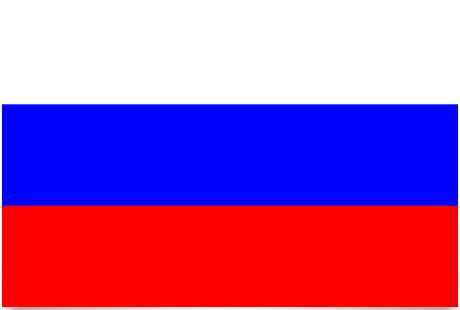Russia Flag and Meaning
Flag of Russia

Russia Flag Meaning
Russia’s flag was adopted, again, on August 22, 1991 after a failed coup attempt against incumbent President Michael Gorbachev and became Russia’s national flag following the dissolution of the Soviet Union in December of that year. This flag was used before the Soviet flag and the communist takeover in 1917. The
colors of the flag are believed to stem from connections to Moscow’s coat of arms where Saint Göran is dressed in a blue coat riding a white horse against a red background. Russia’s tricolor, like many other flags, is inspired by the Dutch flag. Another theory about the colors is that white stands for God, blue for the tsar and red for the peasants. And a third known theory says that the colors stand for Russia’s former empire: White forBelarus, blue for Ukraine and red for Greater Russia.
Russia Overview
| Population | 145.5 million |
| Currency | Russian rubles |
| Area | 17,075,400 km² |
| Capital city | Moscow |
| Population density | 8.5 residents/km² |
| HDI location | 65 |
Earth’s largest state. It can be divided into 5 main regions: European Russia stretching from the western border to the Ural Mountains – traditionally perceived as the border between Europe and Asia – is a huge lowland area intersected by the rivers Volga, Don and the Dnieper. It is the richest region of the Russian Federation. The Urals range from north to south and contain important mineral and oil deposits. Siberia extends from the Ural Mountains to the Pacific. This vast area is rich in natural resources but is sparsely populated due to the harsh climatic conditions. The Caucasus region is a vast steppe region that extends north of the mountains of the same name between the Black Sea and the Caspian Sea. Parts of Russian Central Asia lie beneath the ocean’s surface and are made up of desert, steppes and mountains.
Cereals, potatoes and beet are grown in the plains. In Central Asia, cotton and fruits are grown. Tea, grapes and citrus fruits are grown in the subtropical regions of the Caucasus and the Black Sea. The country has vast mineral resources: Oil, coal, iron, copper, zinc, lead, bauxite, manganese and tin in the Ural Mountains, Caucasus and Central Siberia.
Chelyabinsk is a city south of Ural. It is plagued by extensive radioactive pollution from the plutonium plant in the area. The heavy industry and the mines are contributing to increasing pollution of the country’s most important rivers, urban air and land. The pollution also contributes to the extensive use of coal in the power plants, nuclear power plant failures and the excessive use of agrochemical products. Finally, extensive areas are plagued by deforestation and soil erosion.
People: Russians (81.5%), Tatars (3.8%), Ukrainians (3%) and 100 other nationalities (1996)
Religion: Predominantly Russian Orthodox as well as Muslim, Protestant and Jewish minorities.
Languages: Russian (official) but in addition there are as many languages as nationalities.
Political parties: Our Home Russia and Russian Option – both neoliberal and support parties for Putin. The Liberal Democratic Party – right-wing nationalist. Communist Party. The Democratic Agrarian Party. Yabloko. Congress of Russian Society.
Social organizations: Federation of Independent Russian Trade Unions (FNPR) with over 40 million members. The professional association Sotsprof with 1 million members.
Official Name: Rossiyskaya Federatsiya.
Administrative Division: The Russian Federation consists of 26 autonomous republics: Bashkortostan (formerly Bashkiria), Chechenya-Ingushetia, Chuvashia, Dagestán, Kabardino-Balkaria, Kalmukia, Komis, Mari-El, Mordovia, North Osetia, Tatarstan, Tuva and Saja (formerly Yakutia);
The regions of Adigueya, Gorno-Altai, Hebrew, Karachaevo-Circasia;
The provinces of Buriata in Aguin, Buriata in Ust-Ordin, Chukchis or Dolgano-Neneos in Taimir, Evencos, Janti and Mansi, Koriakos, Neneos and Yamalo-Neneos.
Capital: Moscow, 10,562,000 residents (2010).
Other important cities: Skt. Petersburg (formerly Leningrad), 4,656,000; Nishni-Novgorod, 1,351,800 residents; Novosibirsk, 1,397,800 in.; Ekaterimburg (formerly Sverdlovsk), 1,347,000 residents; Samara, 1,522,500 residents; Omsk, 1,116,200 residents; Chelyabinsk, 1,124,500 residents; Kazan, 1,092,300 residents; Ufa, 1,091,800 residents; Perm, 1,086,000 residents; Rostov at Don, 1,023,200 residents (2000).
Government: Vladimir Putin, President since May 2012. Dmitry Medvedev, Prime Minister since May 2012. Parliamentary Republic. Parliament has two chambers: the State Duma with 450 seats and the State Council with 178.
National Day: June 12 (Russia Day, 1990)
Armed Forces: 1,270,000 (1996).
Paramilitary forces: 220,000













































